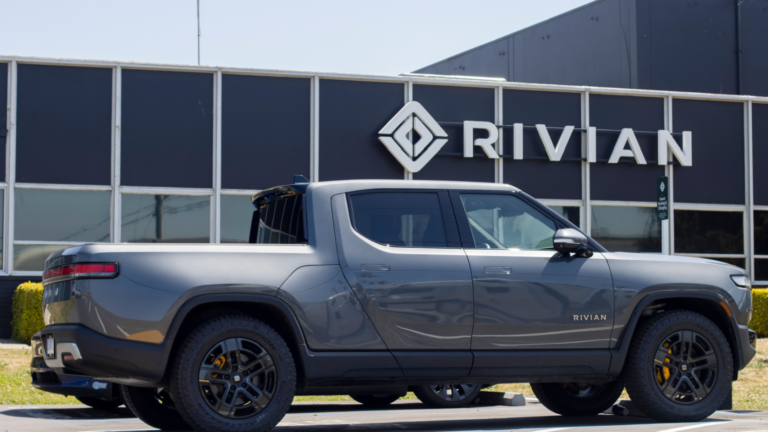Rivian Automotive (NASDAQ:RIVN) is a U.S.-based electric vehicle producer gearing up to release its second-quarter 2024 earnings after the bell on August 6. Based on its key financial and operational indicators, Rivian stock is a ‘Hold’ going into the upcoming earnings report.
Production and delivery figures have met expectations, yet profitability still needs to be achieved. Additionally, the broader EV market is competitive and unstable at the micro-level.
While there are positive trends among analysts’ top and bottom-line estimates for RIVN based on cost reductions and increased production edge, challenges persist. Rivian must optimize its internal cost structures, and the upcoming financial results will provide insights into the company’s progress toward profitability. Rivian’s strategic initiatives, including developing the R2 platform, are critical. These initiatives aim to broaden Rivian’s market appeal and enhance its product lineup. Given the mixed financial indicators and the high expectations for future production, standing on the neutral side for Rivian stock seems prudent.
In short, this approach allows one to gauge the company’s performance post-earnings before making further investment decisions.
Operational Highlights and Financial Projections
Rivian produced 9,612 vehicles and delivered 13,790 in Q2 2024, aligning with its annual production goal of 57,000 vehicles. The company’s recent plant upgrades have improved production efficiency, which should help Rivian reduce costs and boost margins. However, Rivian still needs to be more profitable. The expected Q2 EPS is -$1.19, showing ongoing financial challenges.
Otherwise, Q2’s revenue growth was $1.15 billion, an anemic 2.87% gain YoY. During the last 90 days, analyst EPS estimates changed 15 times. Revenue estimates saw 12 upward and five downward revisions, which indicates uncertainty among analysts regarding Rivian’s financial stability.
Additionally, Rivian’s recent earnings surprises show a mixed trend. The company beat EPS expectations six times and missed two times in the past two years. For revenue, it beat expectations five times and missed three times. Hence, this inconsistency adds to the cautious outlook on Rivian stock before the Q2 earnings.
Market Position and Strategic Initiatives
Rivian’s market position is solidifying in the competitive EV sector. It was the fifth best-selling EV maker in the U.S. in Q1 2024. The company’s R1T pickup received top safety ratings, boosting consumer confidence. Rivian’s focus on vertical integration and continuous product enhancements also sets it apart.
Moreover, the company has introduced around 30 updates since starting production, reflecting its commitment to improving the user experience. Rivian’s transition to a new zonal network architecture has reduced electronic control units by 60%, cutting costs significantly. Despite these advancements, the company’s path to profitability is still under construction.
Looking forward, Rivian’s R2 platform, set to launch in 2026, promises further growth. This new midsize SUV, priced at around $45,000, will target a broader market. The R2 production shift to the Normal, Illinois, plant will save over $2.25 billion. Hence, these strategic moves are crucial for Rivian’s long-term lead.
Hold Tight: Rivian’s Q2 Earnings Will Clarify Future Prospects
Despite positive trends, risks remain. Rivian’s ongoing financial losses and high production costs are major concerns. The company’s ability to attain profitability in the near term is still being determined. Rivian’s gross profit per vehicle is still negative.
However, improvements are expected in the second half of 2024. Market volatility and competitive pressure could also impact Rivian’s performance. This is especially true of giants like Tesla (NASDAQ:TSLA) in the EV sector. The company needs to continue innovating and reducing costs to stay competitive. Thus, any delays in production or product launches could adversely affect market sentiment and stock performance. Rivian’s strategic initiatives are promising, but execution risks remain.
Overall, one should consider holding (not making any new trade) Rivian stock until after the Q2 earnings report. This will allow for a more sharp decision based on updated financial data. Key areas to watch include EPS performance, revenue growth, and updates on strategic initiatives like the R2 platform. Rivian’s innovative approach and strategic cost reductions could generate profitability in the long term. However, current uncertainties warrant a hold rating.
On the date of publication, Yiannis Zourmpanos did not hold (either directly or indirectly) any positions in the securities mentioned in this article. The opinions expressed in this article are those of the writer, subject to the InvestorPlace.com Publishing Guidelines.
On the date of publication, the responsible editor did not have (either directly or indirectly) any positions in the securities mentioned in this article.

